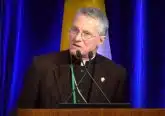Analysis: The end of business as usual for the USCCB?
by JD Flynn
Denver Newsroom, Aug 21, 2020 / 01:23 pm MT (CNA).-
The U.S. bishops’ conference has canceled its in-person November meeting in response to the coronavirus pandemic. Sources say that conference leadership is now considering whether to conduct an abbreviated virtual meeting in place of the canceled event.
If the bishops do conduct an online session, it will be their first meeting of any kind in a year, because the June meeting of the conference was itself canceled amid the pandemic.
The U.S. bishops were informed in an Aug. 17 letter from Archbishop Jose Gomez that the meeting will not take place in person, and that it could take place virtually if that plan is supported by a plurality of bishops.
But there is a list of pressing issues facing the Church in the U.S., and many of them are unlikely to be addressed meaningfully in a virtual session. As a result, some bishops may push for an in-person gathering to be scheduled as soon as possible. But others may see the diminished capacity of the conference to gather as an opportunity, and take advantage of that opportunity in their own dioceses.
Many conference staffers have told CNA they are eager for in-person meetings of bishops to resume, especially at the committee level. There is a push in the conference to ensure that priorities and projects are driven by bishops, not staff members. But in the absence of personal meetings with bishops in committees, it is harder for staff members to be sure their work reflects the intentions of the bishops, and harder for managers, and bishops, to hold staff members accountable to that mandate.
Still, there are a few items of business that the bishops’ conference would be able to address easily in an online November meeting.
The bishops will need to vote on several committee chairmanships, a strategic plan that has been in development for several years, and on some other procedural business.
The bishops will also have to elect a new general secretary, who functions as the executive director of the conference staff in Washington, DC.
The term of Monsignor Brian Bransfield, who is now conference general secretary, will expire in November. Bransfield, a priest of Philadelphia, has spent more than a decade working at the conference, the last five as general secretary.
His successor must be a priest or an auxiliary bishop (a theoretical possibility which seems highly unlikely). While candidates for Bransfield’s replacement have not yet been announced, many in the conference think the smart bet is on the inside candidate, Msgr. Jeffrey Burrill, who has been Bransfield’s deputy since 2016.
Burrill, a Wisconsin priest, is generally regarded as theologically orthodox, intelligent, and pastoral. He has been described as a “common sense guy” by some conference staffers, who say that if elected, Burrill might seek to streamline and simplify some of the procedural and bureaucratic aspects of the conference’s day-to-day operations.
Whoever follows Bransfield will face a raft of issues, many of which will not be easily handled by bishops meeting virtually.
The first of those is a changing financial reality for the Church. Conference staffers have told CNA that the bishops’ conference has adopted several belt-tightening measures in recent months, a hiring freeze, and a moratorium on travel among them. Coupled with the savings realized by the closure of its DC headquarters during the pandemic, and the conference may actually be under budget in its current fiscal year.
But the future may not be as rosy. Five U.S. dioceses have declared bankruptcy in 2020, and eight in total have done so since the McCarrick scandal broke in 2018. More dioceses face cash crunches after months of dramatically reduced collections, and it is likely that some will find themselves unable to pay their annual obligation to the conference, or disinclined to choose doing so while at the same time laying off employees. The conference may soon find itself needing to make do with much less cash than it is accustomed to, living on the return of its market portfolio and on diminished collections from dioceses.
Bishops will have a difficult time discussing, in any practical way, what offices and projects to prioritize in a dim budget forecast, if they’re asked to do so in a Zoom meeting.
They’ll also have a difficult time discussing the policy priorities of the conference in the immediate aftermath of a national election. There is also a growing problem that some Catholics hope the bishops will address: continued distrust on the part of many Catholics following the McCarrick scandal. That distrust has been exacerbated by the challenges of the pandemic and protests of 2020, and by the growing influence of social media figures fomenting skepticism of their bishops among many young, practicing Catholics. Some bishops likely think the influence of such figures is exaggerated, but younger practicing Catholics, who talk with each other on social media and by text about the issues of the day, see the growing influence of those voices.
And, as a background to all of those things is that a declining number of people were practicing Catholicism before the scandals and the pandemic, and the mandate of evangelization remains the preeminent mission of the Church herself, and a mandate for all believers.
Bishops can’t easily discuss such matters online. It is difficult, in fact, to meaningfully discuss such matters at all, let alone in a Zoom meeting. Some discussion can be facilitated in regional meetings conducted by conference call or by Zoom, but if the USCCB wants to address meaningfully as a body the challenges and mission of the Church in the U.S., there is a certain urgency to resuming personal meetings.
But there are some bishops who hold that such discussions aren’t properly the prerogative of the USCCB anyhow. Some bishops hold that the conference really ought to meet only to address the limited range of issues it is empowered by canon law to act upon, and to coordinate some lobbying initiatives at the federal level on behalf of the entire Church. Still other bishops believe that the deliberations of the assembled conference are an exercise in rhetorical exhibitionism, but rarely influential on the actual pastoral work in their local churches.
Those bishops – who express frustration routinely with “mission bloat” at the USCCB – may take the pandemic, and its limitation on coordinated episcopal action, as an opportunity to strike out more vigorously on their own – to initiate projects and priorities of evangelization, catechesis, and pastoral care in their dioceses without the distraction of the bishops’ conference.
If that becomes the case, individual dioceses might function more freely as diverse settings for testing out new ideas and approaches, the best of which would be adopted at a broader level by imitiation, not by compromise and consensus.
If bishops grow accustomed to handling only abbreviated business via online meetings, it may increase the number for whom the diocese comes into sharper focus as the principal locus of apostolic activity, and for whom the importance of the conference fades. A growing number of bishops may begin to ask, as Archbishop Charles Chaput did in 2019, if all pastoral offices of the conference are worth the investment. That shift could become the most significant event to shape the future of the USCCB.
It will be more than a year between meetings of the U.S. bishops’ conference. Whether that means a pause on business as usual, or the end of business as usual, remains to be seen.













